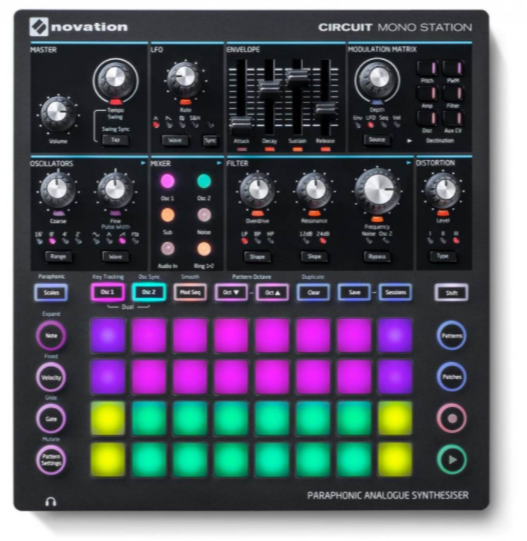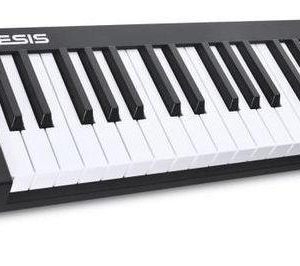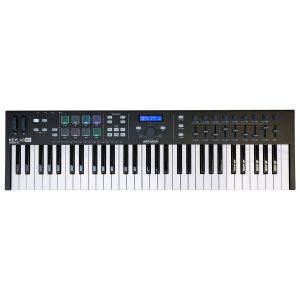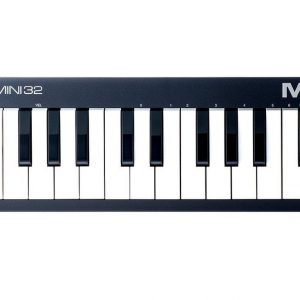Novation Circuit
$234.99
Experience unparalleled versatility with the Novation Circuit midi keyboard – perfect for musicians and producers of all skill levels!
Compare
Description
Novation Circuit: A Revolutionary MIDI Device
Novation, a leading manufacturer of MIDI controllers and performance equipment, has always been an innovator in the field of music technology. Its latest product, the Novation Circuit, is a groundbreaking MIDI device that combines the best features of a synthesizer, drum machine, and sequencer into a single, portable unit.
With over 60 seconds of sample memory, two six-voice polyphonic synth engines, and four-part drum machine, the Novation Circuit is a versatile and powerful music production tool. It features a step sequencer that allows users to program rhythmic patterns and melodies, with up to 64 steps per pattern. The device also has a grid-style interface that makes it easy to input and edit patterns, without the need for a computer or other external device.
One of the most exciting features of the Novation Circuit is its ability to generate a wide range of sounds, thanks to its two synth engines. These engines offer a variety of sound-shaping tools, including a selection of oscillator, filter, and envelope settings. The device also includes a wide range of effects, including reverb, delay, and distortion, to further enhance the sound of individual tracks.
Another standout feature of the Novation Circuit is its portability. Weighing in at just over two pounds, the device is both compact and lightweight, making it easy to take on the go. It also runs on battery power, giving users the freedom to create music anywhere, without the need for an external power source.
In addition to its hardware capabilities, the Novation Circuit also comes with a suite of software tools, including a standalone software editor and the Novation Components browser-based platform. The editor allows users to fine-tune their sounds and sequences, while the Components platform provides access to a range of additional features, such as sample import and sharing.
Overall, the Novation Circuit is a powerful and flexible MIDI device that offers a rich set of performance features, while remaining easy to use and highly portable. Whether you’re a seasoned producer or just starting out, the Novation Circuit offers a new and exciting way to create and perform music, without the need for a computer or other external gear.
Novation Circuit properties
| Product name |
Circuit |
| Brand |
Novation |
| Type |
Keyboard Instruments |
| Keyboard Instrument |
MIDI Keyboard |
| Pads |
Yes |
| Rotary Controls |
Yes |
| Colour |
Black |
Frequently Asked Questions:
"Can I connect my MIDI keyboard directly to a NovaTionius Circuit without needing any additional hardware or software?"
No, you cannot connect your MIDI keyboard directly to a Novation Circuit without needing additional hardware or software. The Circuit does not have built-in MIDI inputs. While the Circuit has 16 onboard pads that can function as a basic MIDI controller, it does not have standard MIDI in/out ports for connecting external MIDI gear directly.
To use your MIDI keyboard with a Novation Circuit, you will need to connect it via USB or purchase a standalone MIDI interface like the Novation Launchkey Mini MK2 or a similar device that has standard MIDI in/out ports and can be connected to your Circuit.
Alternatively, you could use software-based solutions on a computer (if you're using Circuit as a standalone device) or an iPad (if you're using the Circuit for iOS). With these solutions, you will need to connect your MIDI keyboard via USB, Lightning or another compatible connector to the computer/iPad and then route its MIDI signals to the Circuit application. This can be done using a variety of software applications such as AUM or Audiobus for iOS, or a combination of Ableton Live Lite, Novation's Automap Pro, and a MIDI routing software like LoopMIDI for desktop computers.
How can I map specific notes to individual keys on my Novation Circuit MIDI Keyboard?
Beginner's Guide to Novation Circuit | Mapping Notes & Chords
Mapping specific notes to individual keys on your Novation Circuit MIDI Keyboard is a simple process. and here are the steps to do it:
1. Begin by opening up your digital audio workstation (DAW) software, such as Ableton Live or Logic Pro X.
2. Select the MIDI Controller option in the settings menu to open the MIDI controller settings page.
3. Locate and select the Novation Circuit MIDI Keyboard from the list of available MIDI controllers.
4. Click on the Edit button located next to the Novation Circuit MIDI Keyboard slot, which will open up the mapping editor window.
5. In the mapping editor window, locate and click on the "Key Mapping" tab at the top of the screen.
6. On the Key Mapping tab, you will see a list of available keys that can be assigned to specific notes on your keyboard. By default, most of these keys are already assigned to common note ranges such as C, D, E, etc. However, if this does not match what you're looking for, you'll want to modify the key assignments.
7. Click and drag across the available keys to select the ones that correspond to your desired notes.
8. To change a key assignment, click on the key in question and then use the numeric keypad or alphabetical keypad to input the note name (e.g., middle C is 61). Alternatively, you can type out the note name using the software's keyboard shortcuts.
9. Once you have mapped your desired notes to their corresponding keys, click on the "Save" button located at the top of the mapping editor window to save your settings.
That's it! You now have successfully mapped specific notes to individual keys on your Novation Circuit MIDI Keyboard.
How does the Novation Circuit's integrated synthesis engine differ from other MIDI keyboard devices on the market?
The Novation Circuit's integrated synthesis engine is unique in that it combines both digital and analog sound generation technologies. Most other MIDI keyboard devices either use all-digital or all-analog synthesis, with some exceptions. This combination allows for a wider range of sounds and textures to be created, as well as greater flexibility in manipulating those sounds through the various filters, envelopes, and modulation sources available in the Circuit's engine. Additionally, the Circuit's intuitive grid-based interface and built-in sequencing capabilities make it a powerful tool for creating dynamic and complex compositions without the need for external software or hardware.
What is the optimal software integration process for syncing external devices, such as synthesizers and drum machines, with Novation Circuit using MIDI?
The optimal software integration process for syncing external devices, such as synthesizers and drum machines, with Novation Circuit using MIDI involves the following steps:
1. Ensure that your external devices support MIDI synchronization. Check their manuals or consult their manufacturers' websites to confirm this feature. Connect your external devices to your computer via USB or MIDI interfaces, depending on their input/output options. For example, some synthesizers may have built-in USB ports for MIDI communication, while others might require a separate MIDI interface. Launch the Novation Circuit software and create a new project or open an existing one. Go to the MIDI settings menu by clicking on "Preferences" in the main menu bar, then select "MIDI Setup". In the MIDI Setup dialog box, click on the "+" button to add your external devices as MIDI inputs or outputs, depending on their roles in the synchronization process. For example, you might want to add your synthesizer as a MIDI input to receive Circuit's sequencer data and your drum machine as a MIDI output to trigger its sounds from Circuit's patterns. Specify the MIDI channels, baud rates, and other settings for each device according to their specifications. You might need to consult their manuals or trial-and-error methods to find out what works best. Save your MIDI Setup configuration by clicking on "OK" and close the Preferences window. Start playing around with your external devices and Circuit in the same session, following their respective user manuals for proper operation. You can use Circuit's internal sequencer to trigger the external devices or vice versa, depending on your preferences and needs. If you encounter any synchronization issues, such as dropped notes or incorrect timing, try adjusting the MIDI delay, clock source, or other settings in the Circuit software's MIDI Setup dialog box. You can also consult Novation's support resources or external device manufacturers' forums for further advice and troubleshooting tips. Finally, remember to always turn off your devices properly and safely before unplugging them from their power sources or USB/MIDI interfaces. This will help prevent damage or data loss due to improper shutdowns or electrical surges.
What is the difference between the 'Scene' and 'Pattern' modes on the Novation Circuit, and how do they affect the editing of user-created sequences?
Scene mode and Pattern mode. In Scene mode, you can store and recall up to 16 Scenes. Each Scene typically contains a collection of Patterns that work together to create a cohesive musical idea or section. When you're in Scene mode, you can select any of these stored Scenes and play them back, but you won't be able to edit the individual Patterns within those Scenes directly. On the other hand, Pattern mode allows you to access up to 64 Patterns (4 Pages x 16 Patterns per Page), which are essentially standalone musical ideas. In Pattern mode, you can select any of these stored Patterns and make changes to them as needed, such as tweaking parameters or adjusting note lengths. When editing user-created sequences in Pattern mode, you have more flexibility than in Scene mode. You can modify the individual Patterns that make up a Scene by selecting each Pattern within that Scene, making adjustments, and then saving those changes back into the original Scene. However, if you're working in Scene mode, you'll need to first switch over to Pattern mode, select the desired Pattern, make your edits, and then return to Scene mode. This can be a bit more cumbersome than editing directly within Pattern mode, but it still allows for extensive customization of user-created sequences. Keep in mind that some advanced features, such as assigning effects to individual Patterns or creating custom Scenes with specific arrangements, are available when working in both modes.
Before you buy Novation Circuit






Reviews
There are no reviews yet.